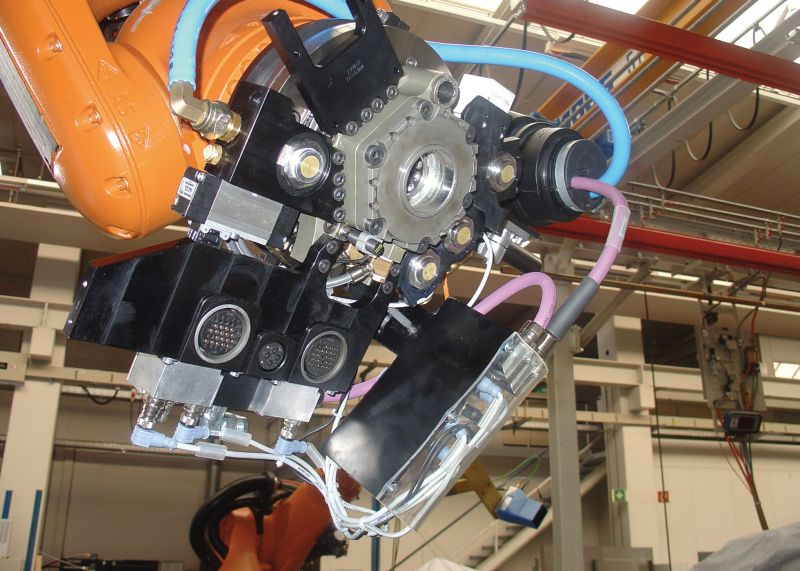 The use of Stäubli automatic tool changers at Audi’s A8 factory in Germany has increased the flexibility of the body-in-white production line as well as reducing space requirements and investment in automation equipment
The use of Stäubli automatic tool changers at Audi’s A8 factory in Germany has increased the flexibility of the body-in-white production line as well as reducing space requirements and investment in automation equipment
Flexibility in manufacturing is essential in the competitive automotive production environment. And being able to produce a range of different models, essentially based on one platform, is a pre-requisite for efficient, cost effective manufacture. The demand this places on production tooling is significant, it increases the number of tools needed in each cell, creating more tool changes with the potential danger of lower cell productivity. The use of Stäubli automatic tool changers removes these problems and reduces the need for any additional investment in space or equipment.
Audi’s plant at Neckarsulm, Germany, produces the base models A6 and A8 in saloon and avant (estate) versions as well as higher spec variants. The body plant for the A8 is fully automated, each processing cell containing a number of 6-axis robots as well as several welding, riveting, hemming, gripping and glueing tools. Stäubli tool changers are used throughout.
Typical is the under body production cell where four robots share ten tools to spot weld and hold the panels or the stud welding cell where eight tools are shared between four robots. Tool changes on each robot arm are automated using Stäubli tool changers.
Tools of the trade
 Tool changer models 360 and 500, with payload capacity up to 500kg, are used on spot and stud welding guns. Automatic, clean break connections are made for air, fluids, hydraulics and water, with power and data system connections being made simultaneously. In standard form a maximum working pressure of 320 bar provides the power to operate each of the selected tools while the robust wrought steel construction and patented secure locking systems – either electric or pneumatic – are built to withstand the forces encountered during the process. An electric option is also available which is particularly useful when compressed air is not available in the cell or a totally electric cell is required. The modular construction of the 360 and 500 models allow individual connectors to be specifically selected for each application.
Tool changer models 360 and 500, with payload capacity up to 500kg, are used on spot and stud welding guns. Automatic, clean break connections are made for air, fluids, hydraulics and water, with power and data system connections being made simultaneously. In standard form a maximum working pressure of 320 bar provides the power to operate each of the selected tools while the robust wrought steel construction and patented secure locking systems – either electric or pneumatic – are built to withstand the forces encountered during the process. An electric option is also available which is particularly useful when compressed air is not available in the cell or a totally electric cell is required. The modular construction of the 360 and 500 models allow individual connectors to be specifically selected for each application.
Space is critical in the body plant and the ability to compress into one cell several welding and riveting operations by using tool changers, dramatically reduces the space required by minimising the total number of cells. Their use also gives major benefits in terms of cell flexibility with any modifications to tooling or sequencing being easily assimilated. Audi regard the tool changers as being virtually maintenance-free – just a visual check on wipe over being all that is required.
All of the tool changers are directly mountable on the robot flange and provide secure locking and unlocking of each tool used. The locking unit is failsafe in case of power loss. Fluid connections are made using Stäubli clean break, non-spill, flush faced couplings. Electrical, signal and optical connections use products manufactured by a subsidiary company in the Stäubli group, recognised as a leading specialist in electrical connections. This gives Stäubli the facility of having both mechanical and electrical connection expertise in house.
Across the body shop up to 500 tool changes are made each day, and some of the Stäubli tool changers have made over two million changes and are still working to an accuracy of 0.5mm, actually higher than that achieved by the robots themselves.
Stäubli UK
T: 01952 671 918

